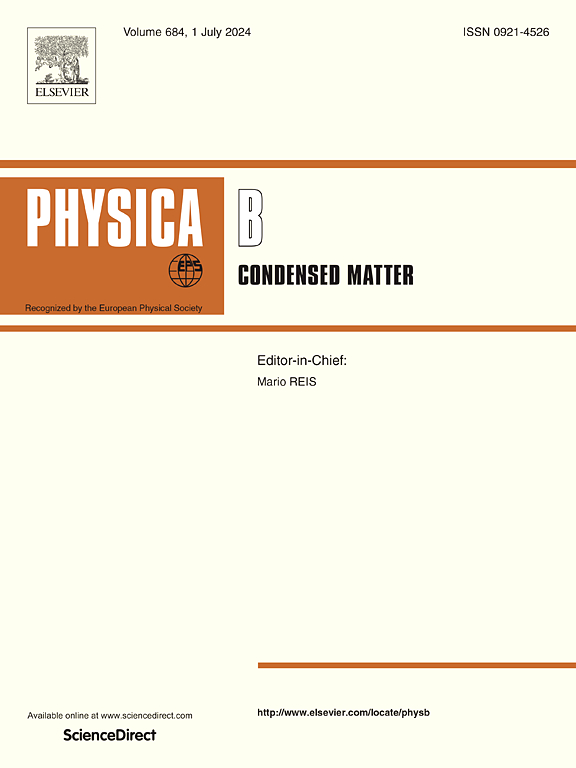Tunable electronic and chemical properties of Fe@Sin clusters: Potential in nanoelectronics and sensing, a DFT-based study
IF 2.8
3区 物理与天体物理
Q2 PHYSICS, CONDENSED MATTER
引用次数: 0
Abstract
We present a comprehensive Density Functional Theory (DFT) study on the structural, electronic, and chemical properties of Fe-doped silicon clusters (Fe@Sin, n = 1–10) to understand their stability and potential applications in nanoelectronics and catalysis. The binding energy (BE) analysis reveals that Fe@Si7, and Fe@Si8 exhibits the high stability, attributed to strong Fe-Si interactions. Additionally, the second-order energy difference (Δ2E) highlights Fe@Si4, Fe@Si7 indicating enhanced nature. The HOMO-LUMO gap trends suggest a transition from semiconducting to metallic behavior which further confirmed through density of states analysis. Electron affinity (EA) and ionization potential (IP) calculations indicate that Fe@Si6 and Fe@Si7 possess strong charge storage and redox activity, making them promising candidates for catalysis and energy storage applications. Furthermore, the chemical potential (μ) and hardness (η) trends confirm Fe@Si8 as the most stable cluster, whereas Fe@Si7 is highly reactive and may be suitable for chemical sensing or catalytic applications. These findings provide crucial insights into the tunability of Fe@Sin clusters, paving the way for their potential use in nanoelectronic devices, catalysis, and energy storage, and sensing applications.
Fe@Sin簇的可调谐电子和化学性质:纳米电子学和传感的潜力,一项基于dft的研究
我们对掺铁硅团簇(Fe@Sin, n = 1-10)的结构、电子和化学性质进行了全面的密度泛函理论(DFT)研究,以了解它们的稳定性和在纳米电子学和催化方面的潜在应用。结合能(BE)分析表明,Fe@Si7和Fe@Si8由于Fe-Si的强相互作用,具有较高的稳定性。此外,二阶能量差(Δ2E)突出显示Fe@Si4, Fe@Si7表示增强的性质。HOMO-LUMO间隙趋势表明从半导体行为到金属行为的转变,通过态密度分析进一步证实了这一点。电子亲和(EA)和电离势(IP)计算表明Fe@Si6和Fe@Si7具有很强的电荷存储和氧化还原活性,使它们成为催化和储能应用的有希望的候选者。此外,化学势(μ)和硬度(η)趋势证实Fe@Si8是最稳定的簇,而Fe@Si7具有高活性,可能适用于化学传感或催化应用。这些发现为Fe@Sin簇的可调性提供了重要的见解,为它们在纳米电子器件、催化、能量存储和传感应用中的潜在应用铺平了道路。
本文章由计算机程序翻译,如有差异,请以英文原文为准。
求助全文
约1分钟内获得全文
求助全文
来源期刊

Physica B-condensed Matter
物理-物理:凝聚态物理
CiteScore
4.90
自引率
7.10%
发文量
703
审稿时长
44 days
期刊介绍:
Physica B: Condensed Matter comprises all condensed matter and material physics that involve theoretical, computational and experimental work.
Papers should contain further developments and a proper discussion on the physics of experimental or theoretical results in one of the following areas:
-Magnetism
-Materials physics
-Nanostructures and nanomaterials
-Optics and optical materials
-Quantum materials
-Semiconductors
-Strongly correlated systems
-Superconductivity
-Surfaces and interfaces
 求助内容:
求助内容: 应助结果提醒方式:
应助结果提醒方式:


